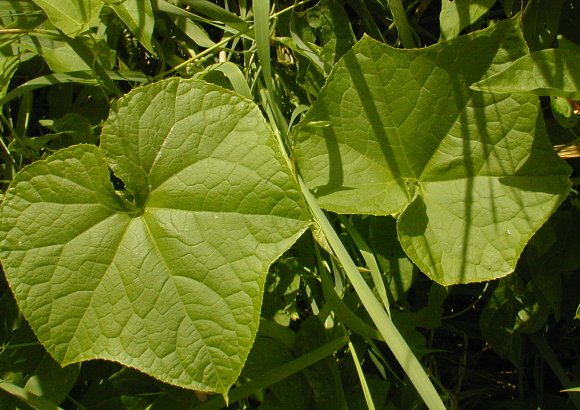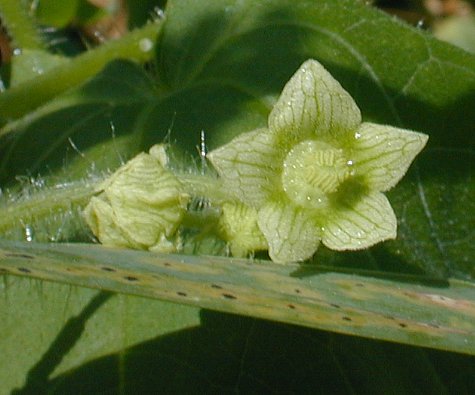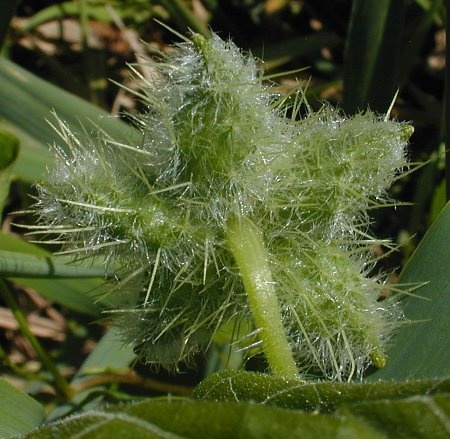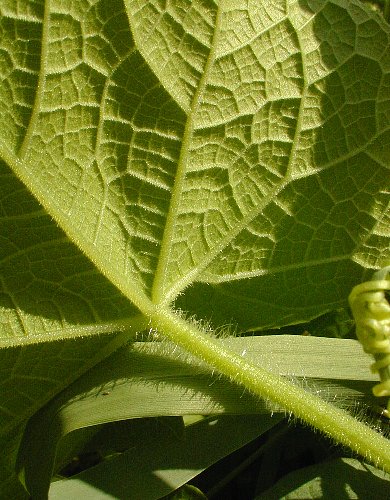Description: This herbaceous plant is an annual vine up to 25' long that develops multiple lanky stems. This vine can climb over adjacent vegetation and fences using its branched tendrils, otherwise it sprawls across the ground. The stems are light green, terete, furrowed, and quite hairy. The alternate leaves are up to 8" long and across (excluding the petioles); they are orbicular-angular with 3-5 palmate lobes that are shallow to moderately deep. Leaf margins are slightly serrated. The upper surface of each leaf is yellowish green or medium green and relatively hairless, while the lower surface is finely pubescent, especially along the lower veins. The petiole of each leaf is up to 5" long; it is light green, rather stout, and quite hairy. The leaf blade is strongly indented at the base where it is connected to the petiole. Occasionally, branched tendrils and racemes of flowers occur oppositely from the alternate leaves along the vine. Bur Cucumber is usually monoecious and produces both staminate (male) and pistillate (female) flowers on the same plant.

Each staminate flower has a green calyx with 5 teeth, a greenish white corolla with 5 spreading lobes, and a central column of stamens that is knobby at its apex. The teeth of the calyx are short and broad with recurved tips. The lobes of the corolla have a network of green lines on a white background. The staminate flowers are individually about 1/3" across and they tend to bloom in small clusters toward the apex of the raceme. Each pistillate flower has a large ovary that is enclosed within an ovoid fruit about ½" long. The surface of this fruit is covered with sharp spines and long white hairs; it is initially green, but later turns brown. A single style is exerted from the terminal end of this fruit. The pistillate flowers are bunched together in a short raceme; a typical raceme has 3-10 pistillate flowers. The peduncles and pedicels of both staminate and pistillate racemes are light green and pubescent. The blooming period occurs from late summer to early fall and lasts about 3 weeks. There is no noticeable floral scent. Each bur-like fruit contains a single large seed that is brown and flattened; this seed is tapered at one end more than the other and it has a rough surface. The root system consists of a shallow branched taproot. This plant spreads by reseeding itself.

Cultivation:
The preference is full or partial sun, moist conditions, and a fertile
soil that is loamy or silty. During hot dry weather, the large leaves
have a tendency to droop during the middle of the day, but they usually
recover at night if there is adequate moisture in the ground. The seeds
germinate after the soil becomes warm.
Range & Habitat:
The native Bur Cucumber occurs occasionally in scattered counties
across Illinois (see Distribution
Map). Habitats include openings in floodplain forests, moist
meadows in floodplain areas, thickets, banks of ditches and rivers, and
edges of fields. Moist disturbed areas are preferred.

Faunal
Associations:
The nectar of the flowers attracts long-tongued bees (including
honeybees & bumblebees), Sphecid wasps, Vespid wasps, and
various kinds of flies. Wasps are especially attracted by the
accessible nectar of the staminate flowers. Some of the bees also
collect pollen from the staminate flowers. Insects that feed on the
foliage, plant juices, and other parts of Bur Cucumber include the leaf
beetle Acalymma gouldi,
Acalymma vittatum
(Striped Cucumber Beetle),
Diabrotica undecimpunctata (Spotted Cucumber Beetle), Anasa armigera
(Horned Squash Bug), the squash bug Anasa repetita, and
the Coreid bug Leptoglossus
gonagra. The spiny fruits of Bur Cucumber can cling to the
fur of mammals, which helps to distribute the seeds. Mammalian
herbivores usually shun the foliage as a food source. The fruit is
inedible.
Photographic Location:
A flood-prone meadow (or thicket) along a drainage ditch in Champaign,
Illinois. This meadow became a thicket in some areas because of
scattered shrubs and vines.

Comments: Bur Cucumber is easy to identify once it begins to flower and forms fruits. It differs from Echinocytis lobata (Wild Cucumber) by its hairy stems, whereas the latter species has smooth stems. Both of these species produce bur-like fruits, but the fruits of Wild Cucumber are larger (about 2" long) and occur individually, rather than in small clusters. The staminate flowers of Wild Cucumber are usually more showy and occur on longer racemes. The cultivated members of the Gourd family are originally from Central America, South America, or Eurasia. This includes cucumbers, summer squash, winter squash, and many melons. While these cultivated plants occasionally escape into neighboring areas, they rarely persist. They have yellow flowers that are variable in size (from small to very large), while their fleshy fruits are often edible and larger in size than their wild counterparts.